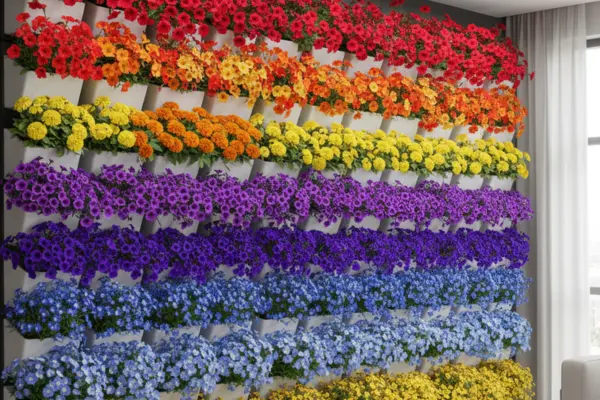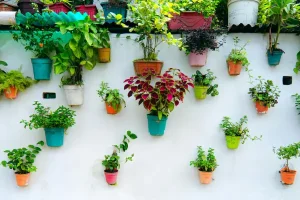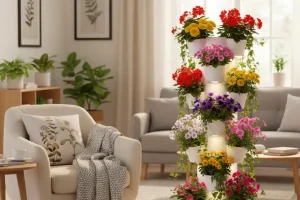A vertical flower garden is beautiful on its own, but with a little planning, it can become a true work of art. One of the most striking design techniques is color blocking—grouping flowers of the same color together in bold, contrasting sections. This approach turns an ordinary vertical garden into a living painting, full of depth and personality.
In this article, we’ll explore how to design a color-blocked vertical flower garden, from choosing the right plants to arranging them for maximum impact.
Why Color Blocking Works
Color blocking is popular in fashion and interior design because it’s simple, bold, and instantly readable. The same idea makes vertical gardens look clean and intentional. By planting flowers in clear clusters of distinct colors, you guide the eye and turn a plain wall into a tidy, high-impact display.
- Visual drama: Large swaths of one hue stand out more than scattered mixes, so your garden pops from a distance.
- Organized beauty: Defined blocks feel curated and artistic, not random.
- Easy maintenance: Grouping plants with similar light and water needs keeps care straightforward.
- Seasonal flexibility: Swap one color block at a time to refresh the look without redoing the whole wall.
- Stronger photos: Clean color fields photograph better for social posts, listings, or portfolio shots.
Step 1: Choose a Color Palette
Decide on the overall mood you want your vertical garden to convey.
- Warm tones: Red, orange, and yellow for an energizing display.
- Cool tones: Blue, purple, and green for a calming effect.
- Pastels: Soft pinks, lavender, and cream for a romantic look.
- Monochrome: Shades of one color for sophistication (e.g., all-white blooms).
Step 2: Select Flowers by Color and Season
Here are popular vertical-friendly flowers grouped by color:
Red & Orange: Geraniums, marigolds, petunias, begonias.
Yellow: Pansies, calendula, snapdragons, sunflowers (dwarf).
Blue & Purple: Lobelia, violas, salvia, torenia.
Pink & Pastel: Impatiens, dianthus, fuchsias.
White: Alyssum, vinca, daisies.
To maintain blooms year-round, choose seasonal replacements (pansies for winter, petunias for summer, chrysanthemums for fall).
Step 3: Arrange Your Blocks
Color blocking works best when plants are grouped in clusters, not scattered.
- Vertical stripes: Plant tall sections of one color side by side.
- Horizontal layers: Place contrasting colors in stacked rows.
- Checkerboard: Alternate squares of two or three colors for a patterned effect.
- Diagonal sweep: Create movement by planting colors in angled sections.
Step 4: Add Texture and Height
To make your design more dynamic, combine upright and trailing plants within each color block.
- Upright blooms: Snapdragons, salvias, geraniums.
- Trailing flowers: Nasturtiums, ivy geraniums, lobelia.
- Foliage accents: Coleus, ornamental grasses, variegated ivy.
Step 5: Maintain and Rotate
Color blocks are easiest to maintain when plants with similar light and water needs are grouped together.
- Fertilize every 2–3 weeks for vibrant blooms.
- Replace seasonal annuals as they fade to keep blocks bright.
- Trim trailing plants to prevent them from overwhelming other sections.
Quick Design Ideas Table
| Design Style | Color Palette Example | Flower Choices |
| Bold & Warm | Red, orange, yellow | Geraniums, marigolds, snapdragons |
| Cool & Calm | Blue, purple, white | Lobelia, salvia, alyssum |
| Romantic Pastel | Pink, lavender, cream | Impatiens, dianthus, fuchsias |
| Monochrome | All-white tones | Alyssum, daisies, vinca |
Common Mistakes to Avoid
Using too many colors at once
Too many competing hues can look messy instead of intentional. Stick to 2–4 colors.
Ignoring plant needs
Don’t mix sun-loving and shade-loving flowers in the same block.
Not planning for seasonal changes
Some flowers fade in extreme weather—plan replacements in advance.
Neglecting balance
Color blocks should feel evenly distributed. Avoid heavy colors all on one side.
Mixing different growth habits
Tall or aggressive trailers can overwhelm compact plants and blur clean edges—group similar heights and habits together.
Skipping neutral spacers
Without green or silver foliage between bold blocks, colors can visually bleed—add neutral “buffer” rows for clarity.
FAQs
Q: Can I do color blocking indoors?
Yes. Just choose compact flowers suited to indoor light, such as impatiens and begonias.
Q: Do I need trailing flowers for color blocking?
Not required, but they add depth and prevent the wall from looking flat.
Q: How often should I change the layout?
Most gardeners refresh color blocks seasonally to keep blooms vibrant.
Q: Can vegetables and flowers be color-blocked together?
Yes, but keep in mind that vegetables may disrupt the uniform look as they mature.
Next Steps & Related Reading
If you enjoy designing with flowers, see DIY Floral Frames: Creating Artful Vertical Flower Displays for more creative approaches.
For year-round floral color, read How to Extend Bloom Time in Your Vertical Flower Tower.
Conclusion
Designing a color-blocked vertical flower garden is about more than just planting—it’s about creating living art. By choosing a strong palette, grouping flowers in bold clusters, and maintaining seasonal rotations, you can transform your vertical garden into a dramatic, ever-changing display.
Would you design your wall with bold warm colors, calming cool tones, or a romantic pastel theme?




